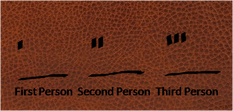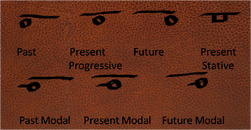During the early formative years of the Mamutok Tribes, the Stargazer realized that the people of the Stargazer Plateau would develop into a collection of tribes rather than a single nation. To account for the inevitable fragmentation of the language into multiple dialects, she developed a written language that focused on the function of the word rather than the pronunciation.
Structure
The written language consists of hieroglyphs, each representing a single word. The symbols are built by starting with a base and adding relevant grammatical details, and finally adding pictorial details to specific the individual word's meaning. The words read left to right. Most words have two forms: a formal form which includes all information about the word's tense, valency, etc. and a common form which excludes these and only includes what is necessary to convey the intended message.
Nouns

Noun Base
Derivational Morpheme
The noun base is a long line at the bottom of the symbol.

The additions to the baseline specify the type of noun.
- Human: Two crossed lines representing a standing man
- Animal: A stick figure animal on four legs
- Location: The "branched tree"
- Thing: The "box"
- Abstract concept or idea: Box on top of the human symbol's head. Literally translates to "human-thing"
Inflectional Morphemes
Person
The "person markers" of a noun are placed in the top left corner of the symbol, and indicate to whom or what the noun is referring. These can be excluded if the subject is implied by context, but are often used to clear up ambiguity.

- First Person: Referring to the self
- Second Person: Referring to the person being addressed
- Third Person: Referring to an outside party or thing
The mark for "Third Person" has evolved into a rude gesture in which a person holds up three fingers, as if to say "You are pretentious and probably speak in the third person," or "You are a third person to me, an outsider. I do not respect you."
Number

The "number markers" are in the top right, and indicate whether the noun is singular or plural. Like the person markers, they are optional unless the context requires them.
Gender

Mamutok people prefer not to use gender unless it is necessary. However they do have markings for it. A male human noun will have a smaller line beneath the "arm line", representing the penis. A female human noun has the same mark above the "arm line", representing breasts. The same markings are used for animals, although they do not have the same visual effect of the symbolism.


Proper Nouns
Proper nouns are denoted with a "crown" mark on top. These serve as the base for people's names.
Pronouns
Pronouns do not require any more than part of speech, person, and number, so for that reason are shortened to just that.
Gerunds
Gerunds, or verbs in the infinitive tense (such as "running" or "to run"), exist as nouns in Mamutok.
Possessive
The noun is not edited for possession. Instead of "X's Y", it is written "Y of X".

Interrogative
Interrogative nouns possess a "question mark" symbol. This symbol can be added to any word, to say things like, "Which animal?"
Verbs
Derivational Morpheme

Verb Base
The verb base is a single long line at the top of the word. Actions are more abstract than things and therefore exist closer to the sky.
Inflectional Morphemes
Person

The person markers exist in the top left, same as nouns. They must match the person of the noun to which they refer.
Number


The number of a verb does not refer to the noun performing the action. Instead, it specifies whether the action was performed a single time or repeatedly. It is denoted by number markers in the top right, same as nouns.
Tense
The tense of the verb indicates when the action was performed or will be performed. This is indicated by a "sun" in the sky. Present tense verbs are progressive, as if to say, "I am running," with a separate form for the stative, unchanging state, "I run".
Modality
A modal verb states that something "might be" or "should be" rather than "is". A "cloud" is placed over the "sun" to indicate uncertainty.
Valency

Valency is important for determining which nouns relate to the verb. The valency markers are placed at the bottom left.
- Avalent: Avalent verbs are those with no subject arguments. This is commonly seen in weather verbs such as "It snows."
- Monovalent: A standard, intransitive verb taking one argument. "He ran."
- Divalent: Transitive verb with two arguments. "He kicked the ball."
- Trivalent: Ditransitive verb with three arguments. "He gave the flower to her."
Quadrivalent verbs and beyond also have the potential of existing, but are rare. In sentences such as, "He bet her two bits that it would rain," The verb "bet" is quadrivalent and modifies "he", "her", and "bits", while the word "it" is a separate argument taken by the verb "would", contained within a prepositional phrase which makes up the entirety of the fourth modified argument.
Adjectives and Adverbs
Dirivational Morpheme

The two bases for adjectives and adverbs.
Adjectives and adverbs are considered the same part of speech. They have a base of a long vertical line on the side of the word. It can go on either the left or the right. This is convenient for writers because it allows them to modify words on either side.
Inflectional Morphemes
Neutrality

Subjective: A subjective descriptor has a box at the bottom of the baseline. It is used to describe things that are a matter of opinion.
Objective: An objective descriptor has a box at the top of the baseline, closer to the heavens. It is used to describe facts.

Superlative
Superlatives are words used for comparison. It can be said that a thing is "X" or that it is "more X" or "most X". It is denoted by adding additional baselines.
Valency

Mamutok treats prepositions as divalent adjectives. The valency lines are the same as with verbs.
Articles

An article a word is that is used with a noun to indicate the type of reference being made by the noun. There are only three articles in Mamutok, and all of them are used fairly commonly. Because of this, they forego the standard morphemes of other parts of speech in favor of quick, simple lines.
- Definite Article: The word "the". Indicates that the noun is a particular one identifiable to the reader.
- Indefinite Article: The word "a". Indicates the noun is non-particular.
- Negative Article: The word "no". Indicates negation. Unlike the other articles, this symbol can be placed before any part of speech in order to negate its meaning.
Conjunctions
"The merchant said I could have the white horse or the gray one. Guess who just got two new horses." -Family Hearth Caravan Customer
Conjunctions also are without morphemes in this language.

- And
- Inclusive Or: X or Y or both X and Y
- Exclusive Or: X or Y but not both X and Y
- Because
- If
- If and only if
Words like "so" and "for" are excluded, as these ideas can be expressed using the already existing conjunctions.
Exceptions
The following words do not follow Mamutok's standard grammar rules:

- Three Lines: This is a vulgar term meaning "You are pretentious and probably speak in third person," or "You are a third person to me, an outsider," or "Fuck you with three fingers." Holding up three fingers is a rude gesture with the same meaning.
- Help: This symbol is made to be quick and easy, and to stand out from other words, in case of emergency.
- Aladeen: This word means "I have forgotten the correct word that I was going to use." It is acceptable in place of any word. It is represented by the "thing box" covered by the "cloud of uncertainty".
Common Phrases and Idioms
- May your teeth grow long.- This is commonly misinterpreted to be a reference to mammoth tusks. In actuality, it refers to the burrowmoles, who must chew in order to wear down their teeth. In essence, this is saying "I hope you have nothing to eat."
Mathematical Language
A different system entirely is used for mathematics. It is the language of the Holy Texts written by the Stargazer, allegedly adapted from her homeworld math language. She claims that while a constructed language might be better than an evolved one, this has withstood the test of time and she will not allow the risk of any ambiguity. It is discouraged to assign meaning to the unknown, so variables borrow letters from the Goran Language instead of Mamutok. Mathematical formulae are often given in both mathematical language and written out in text form, as well as shown geometrically where applicable.